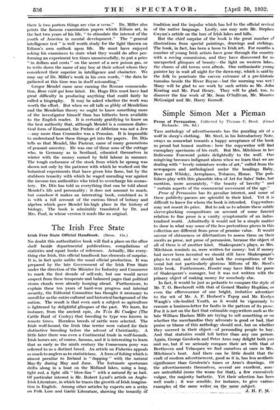Simple Simon Met a Pieman
Prose of Persuasion. Collected by Thcrnas C. Steel. (Grant Richards. 10s. 6d.) THIS anthology of advertisements has the puzzling air of a wolf in sheep's clothing. Mr. Steel, in his Introductory Note. sways us somewhat towards a happy acceptance of the book as proud but honest mutton : here the copywriter will find exemplary specimens of his craft. But Mrs. Mitchison in lwr frolicsome Foreword points delightedly to the wolf. Our misgiVing becomes indignant alarm when we learn that we are dealing with " lovely miniature works of art," culled from the newspapers and anthologized under the headings Baby, Beer and Whisky, Aeroplanes, Tobacco, Home. The pub- lishers play with this plausible idea of Art for. Sales' Sake, but mention, more accurately, " the beauty of brevity " and " certain aspects of the commercial movement of the age." Prose of Persuasion has its peculiar interest, and some of these publicity-paeans are splendid in their kind.' Yet it is difficult to know for whom the book is intended. Copywriters may not resent its price. But to ask us to admire these subtle sleeve-plucking compositions on account of some fancied relation to fine prose is a vanity symptoniatic of an indus- trialized world. Admittedly it would not be a simple matter to show in what way some of the less pretentious pieces in this collection are different from prose of genuine value. It would savour of obtuseness or dilettantism to assess them on their Merits as prose, not prose of persuasion, because the object of all of them is of another kind. Shakespeare's plays, as Mrs. Mitchison reminds us, were written for money: but if money had never been invented we should still have Shakespeare's plays to read, and we should lack the compositions of the vocal but not particula'rly -glorious Miltons of Mr. Steel's little book. Furthermore, Hamlet may have filled the purse of Shakespeare's manager, but it was not written with the prinary -object of making money for somebody else. In fact, it would be just as pedantic to compare the style of Mr. T. 0. Beechcroft with that of Gerard Manley IlopkinS,' or even the effervescence of one bright, imitative advertiser to the wit of Mr. A. P. Herbert's Topsy and Mr. Evelyn Waugh's vile-bodied Youth, as it would be vigorously. to censure a business-letter for faults in the pattern of its prose. For it is not on the fact that estimable copywriters such as the late William Haslam Mills are trying to sell something or on whether the merchandise they advocate is good or bad, that praise or blame of this anthology should rest, but on whether they succeed in their object—of persuading people to buy. And that statistics could tell better than any one person. Again, George Gershwin and Peter Arno may delight both you and me, but if we seriously 'compare their art with that of Beethoven and Velasquez we find ourselves at once in Mr. Mitchison's boat. And there can be little doubt that the craft of modern advertisement, good as it is;has less aesthetic significance than Gershwin's tunes or Arno's dravrings. Of the advertisements themselves, several are excellent, spin:. are untruthful (none the worse 'for that), a few excessively vulgar, the majority bathetic: Yet their' selection has 'been well made ; it was sensible, for instance, to give various examples of, the same. writer on the same _subject.
aI:H.P.11I'






































 Previous page
Previous page